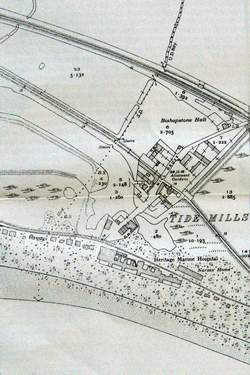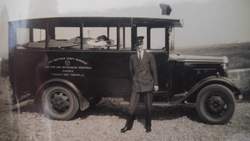Abandoned Communities ..... Tide Mills
We now move on to the last few years of Tide Mills. In 1930, Parliament passed a Housing Act that allowed local authorities to condemn housing as unfit for human habitation. In 1936 the Seaford council took action to declare part of Tide Mills, houses no. 8 to 13, a clearance area within the meaning of the Act. The council seems to have been especially concerned about the alleged sanitary defects of these houses. Water came from a single standpipe shared by all six houses, general waste from the houses was removed and thrown into the sea, and each house had a small outside building containing an earth closet whose contents had to be emptied and carried to the sea. The order confirming the clearance was confirmed by Seaford council early in 1937, and the occupants of the houses were required to vacate them within nine months.
The state of the village was described in colourful terms in an article in the Daily Mail on 2 January 1937. The article had the title Hamlet of Horror. If you have a chance to join the excellent guided tour of Tide Mills run by Kevin Gordon you will be entertained by Kevin reading out several quotations from the article. He will tell you that Tide Mills is Britain's most backward hamlet, without sanitation and without a glimmer of light in its village street. Sandwiched between progressive Seaford and the Continental seaport of Newhaven, it is without a drain. The sea is its sewer, the beach its rubbish dump. Hens scratch in the dirt close to the dwellings, and washing hangs on the line within a few feet of the windows of the children's hospital. The unspeakably primitive conditions are a disgrace to civilisation.
The action of the council, and the reporter from the Daily Mail, may have been influenced by the Matron of the Chailey Heritage Hospital and School. According to the recollections of Percy Thompson, who lived at no. 9 Tide Mills, Miss Powell, the Matron, was not fond of the local children. She would not allow them to play with the boys of the hospital, and if they climbed on a box to look through the window of the hospital she would pull the curtains across.
The people who had to leave Tide Mills in 1937 were offered council accommodation in Vale Road, Seaford. I do not know how many of them moved to Vale Road and how many found homes elsewhere.
The rest of the village of Tide Mills, and the Chailey Heritage Hospital, came to an end early in the Second World War. The shingle beach was needed for defensive purposes. With one exception all the remaining inhabitants of Tide Mills were evacuated in 1940, apparently with just 24 hours notice. Stan Tubb, whose recollections we will consider in a moment, was allowed to stay for a further two months as he had specialised knowledge that was useful to the troops stationed in the area. All the buildings of the village and the hospital were demolished as they would have impeded the view of defending troops and made it more difficult for them to fire on invaders.
The state of the village was described in colourful terms in an article in the Daily Mail on 2 January 1937. The article had the title Hamlet of Horror. If you have a chance to join the excellent guided tour of Tide Mills run by Kevin Gordon you will be entertained by Kevin reading out several quotations from the article. He will tell you that Tide Mills is Britain's most backward hamlet, without sanitation and without a glimmer of light in its village street. Sandwiched between progressive Seaford and the Continental seaport of Newhaven, it is without a drain. The sea is its sewer, the beach its rubbish dump. Hens scratch in the dirt close to the dwellings, and washing hangs on the line within a few feet of the windows of the children's hospital. The unspeakably primitive conditions are a disgrace to civilisation.
The action of the council, and the reporter from the Daily Mail, may have been influenced by the Matron of the Chailey Heritage Hospital and School. According to the recollections of Percy Thompson, who lived at no. 9 Tide Mills, Miss Powell, the Matron, was not fond of the local children. She would not allow them to play with the boys of the hospital, and if they climbed on a box to look through the window of the hospital she would pull the curtains across.
The people who had to leave Tide Mills in 1937 were offered council accommodation in Vale Road, Seaford. I do not know how many of them moved to Vale Road and how many found homes elsewhere.
The rest of the village of Tide Mills, and the Chailey Heritage Hospital, came to an end early in the Second World War. The shingle beach was needed for defensive purposes. With one exception all the remaining inhabitants of Tide Mills were evacuated in 1940, apparently with just 24 hours notice. Stan Tubb, whose recollections we will consider in a moment, was allowed to stay for a further two months as he had specialised knowledge that was useful to the troops stationed in the area. All the buildings of the village and the hospital were demolished as they would have impeded the view of defending troops and made it more difficult for them to fire on invaders.
Four
Tide Mills in 1937
John George Alderson, the driver at Chailey Hospital, standing at the door of the hospital’s Bluebird ambulance. John Alderson lived with his family at no. 4 Tide Mills.

